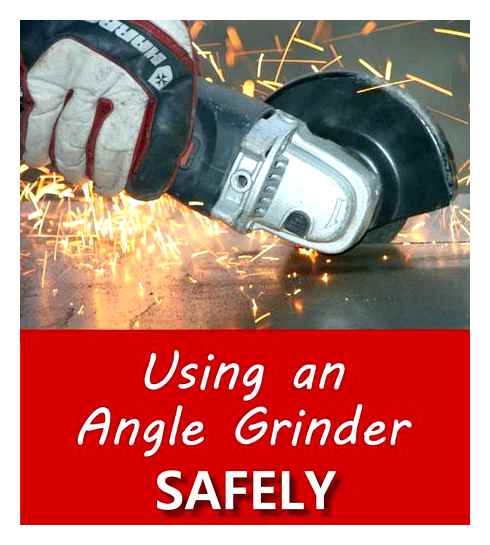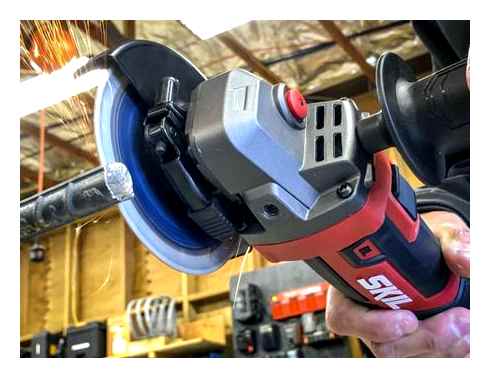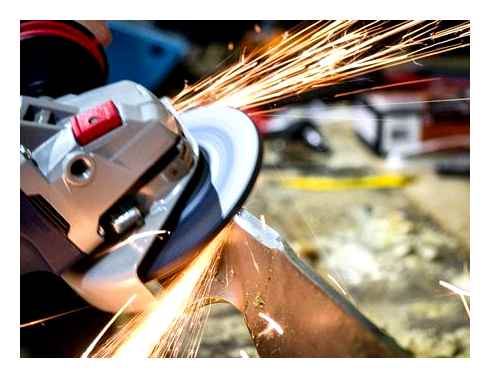a basic knowledge from an amateur
For the beginner about the basics in life safety, extreme and emergency situations, survival, tourism. It will also be useful for fishermen, hunters and other nature lovers and outdoor activities.
How to work properly with an angle grinder (angle grinder)
Work angular sander (angle grinder, in prostanarodi angular grinder), requires certain knowledge, skills and compliance with safety regulations.

With an angle grinder grind surfaces, cut, grind and polish materials of different origin, as well as sharpen the edges of the working tool. Use the device according to the class, type of material and type of work. Knowing how to correctly cut metal and perform specific operations will help you know the purpose of nozzles. They are selected and installed according to the task at hand. Information about the work that can be performed by the angle grinder, provides the manufacturer, and it, together with the technical characteristics, is indicated on the discs (circles). In most cases, it can also be indicated on the packaging of goods.

Operations that can be performed with the angle grinder
The angle grinder is a multifunctional tool. The driving mechanism in it is an electric motor, which through a gearbox transmits motion to the shaft with a removable nozzle mounted on it. General view of the device is shown in the photo below.
On the market there are models with different power and design:
Professional large angle grinder 230mm Stern AG230B
Powerful devices are powered from three-phase voltage of 380 V, and household appliances. from single-phase network of 220 V. There are also low-power cordless models.
Angle grinder (angle grinder) can do with different materials the following basic types of work:
If the angle grinder is fixed, it is possible to grind various tools on the wheel: cutters, drills, knives, etc.
The angle grinder is designed to work with such materials:
Angle grinders are widely used both at home and in industrial applications. This is due to their wide functionality, due to the following factors:
- The Angular grinder has a wide range of accessories made of different materials for different operations;
- the possibility of fixed fixation by means of special fixation devices;
- Some models have additional handles and several speed modes.
In this case you must always remember that only special discs are used for processing each material.
What protection is needed to work with an angle grinder?
To answer the question of how to use an angle grinder, you can not ignore the terms of its safe operation. It is not uncommon for the cutting wheel to be jammed in the material, which can lead to deformation and breaking it into small pieces. Without protection, the operator’s risk of injury is high. Danger also includes flying sparks, the smallest elements of the material to be cut.
When working with an angle grinder must always use a protective cover, which is put on the disc. Its presence ensures the comfortable use of the machine in closed rooms.
It is important for craftsmen to protect eyes and exposed body parts. For this use goggles, masks, gloves. Respirator protects human respiratory organs from dust, especially when working with stone, concrete. Operation of the angle grinder is accompanied by loud noise. Hearing protection can be ensured by wearing earplugs or ear muffs.
As part of the safety of work with the angle grinder must be carried out in tight and non-combustible clothing, special shoes that exclude damage to the feet when you fall tool or heavy elements of the processed material.
How to properly cut with an angle grinder: on itself or away from you
Many households and garages have angle grinders, but most owners don’t know how to hold and use them correctly. That’s why they make mistakes that can lead to defects in the work, and even worse. to serious injuries. You need to remember that the angle grinder is a very dangerous tool. Therefore, before using it, it is necessary to learn a few safety rules.
First of all, it is necessary to take the tool in your hands properly. Right-handed people hold the angle grinder with their right hand by the body. The wheel is on the left and the gearbox is on the right side of the machine.
The left hand should hold the tool by the handle screwed into the body. The correct position of the handle is up. Protective guard must cover the blade and hands, throwing sparks away from the operator.
For the left-hand side the handle is screwed in from the other side of the body, protective cover is rotated and fastened in the required position.
Tool manufacturers give three main tips for working with an angle grinder: hold firmly with your hands, do not stay in the cutting line, stop and do not start the machine if the disc is jammed.
How and in what direction to cut everyone decides for himself, taking into account that when jamming the angle grinder tosses in different directions.
Cut away from yourself
This is a very good method, but it is important to observe one condition. cut away from yourself, with sparks under your feet. In this case, the angle grinder is thrown out when the disc jams, so it is not able to cause any harm. In this case you can perfectly see the cut line drawn for the trimmer, and there is very little chance of doing something wrong. The disadvantage of this method is that the sparks fly on your pants and under your feet.

Cutting on yourself
There are many supporters of this method. It is only important not to forget that when you drive the angle grinder on yourself, sparks are bound to fly in the other direction. This minimizes the risk of the disc jamming. It always stays, though. That is why it is necessary to move the tool away from the cutting line when moving it toward you.
The use of grinding and cutting power tools refers to dangerous activities. Therefore, when working with the angle grinder you need to consider the possibility of direct or indirect exposure to health hazards:
- cold or heat;
- poor illumination of the workplace;
- strong noise, vibration from the machine;
- high physical strain;
- rotating parts of the equipment;
- falling objects (materials being worked on);
- flying sparks and hard particles from parts;
- working at heights, in depths or in confined or inaccessible places;
- risk of electric shock.
To minimize the effects of hazards, and as a consequence, to save life and your own health, you can follow the safety rules for the operation of devices that have open rotating parts. This requires the use of personal protective equipment (PPE for short), good securing of work pieces, choosing a safe place, starting and finishing work correctly.
Personal protective equipment
- goggles or face shield;
- Noise protection headphones or earplugs (earplugs);
- Vibration-isolating gloves;
- Respirator, especially when cutting stone, tile, concrete or slate.
Goggles will protect against sparks, flying splinters or grinding disc. The use of headphones or ear plugs helps to get rid of noise, which helps avoid difficulties with hearing after work. Gloves to protect against abrasion and vibration. And a respirator against the large amount of dust that forms.
Clamping of workpieces
All small and medium-sized parts must be firmly clamped in a vice or with the help of clamps. When securing, a safe place should be provided for possible falling off parts to be cut.
Sometimes it is necessary to machine large parts or constructions which cannot be clamped in a vice. This can be:
DRONCO Safety Basics. How to properly use an angle grinder?
In such cases it is necessary to make sure that the surface to be grinded is firmly fixed (stably standing or lying), does not lose its stability after processing and the cut part does not fall on the employee or other persons. In case of the slightest doubt, use chocks or jacks or securely fasten the slings to the surrounding metal or reinforced concrete structures.
Workplace safety
Requirements for the equipment of the workplace:
- A workbench, table, shelf, cabinet or drawer must be installed for storage and placement of accessories, tools for productive and safe work.
- All fixed equipment is firmly placed (fastened) on the floor.
- Bench and shelf surfaces must not be smaller than the workpieces and tools in use.
- The workbenches surface is made of steel sheet, aluminum and other noncombustible materials.
- Vise must reliably clamp the workpieces. Every 2 to 3 mm of the jaw surfaces must have a 0,5 to 1 mm deep cross groove.
- Vise must be fixed so that the processed parts would be at the level of the worker’s elbow.
- In a closed vice the gap between the jaws should not be more than 0.1 mm. Handle and jaws. without potholes and burrs.
- Movable part of the vice must not fall out when fully unscrewed and must move smoothly, without jerks.
- The floor around the workbench, as well as the entire place of work should be dry and level.
- Power tool sockets are located above the level of the work surface of the workbench.
How to saw wood properly with an angle grinder
angle grinder. it is a versatile tool that is designed for grinding, polishing and sawing concrete, brick, stone, metal. The tool is not originally designed for woodworking. But after installing special tools and supplies, it is quite possible to use an angle grinder on wood. The main thing is to choose the right accessories.
In the professional sphere, the angle grinder is rarely used to work with wooden workpieces. Craftsmen usually have an arsenal of other tools. But in everyday life, if you need to perform woodworking works to buy a set of equipment is not reasonable. First, various jigsaws and saws may only be needed for one time. Secondly, the equipment is not cheap. Therefore, it is much easier to buy special attachments for the angle grinder. Once they are installed, you can saw, cut, and sand wood with any structure. If in the past with the standard equipment could be made only rough cut workpiece, today there are attachments and consumables brand Combo, which allow you to perform quality processing. With their help, you can perform wood carving and sampling, produce stripping, scraping and cutting work.
angle grinder. one of the best sanding tools. With its help it is easy to handle both wooden and metal workpieces. For grinding, you need a support disk and a wheel with sandpaper.
When choosing sandpaper, you need to consider its abrasiveness. This parameter is stated in numbers and represents the number of abrasive particles per 1 cm2 of sandpaper.
Coarse. from 12 to 80 abrasive particles per 1 cm2. It is used for rough primary processing: cleaning of metal parts from rust, rough sanding of wood.
Medium. 80 to 160 abrasive particles per 1 cm2. Used for machining wooden parts.
cutting disc safety basics-How to properly use an angle grinder with cutting disc
fine. 160 to 1400 abrasive particles per 1 cm2. To be used for finish polishing.
angle grinder can grind concrete. This requires a protective casing with a nozzle to which a vacuum cleaner is connected for dust extraction.
Working heads for angle grinder
Working with an angle grinder is impossible without various attachments, which include:
- cutting discs for angle grinders consisting of abrasive material or with appropriately arranged edges (diamond or corundum coating, cutting inserts made of special steel, etc.).д.);
- sanding “cups” and disks also made of abrasive, or steel with different inserts;
- sanding brushes made of resilient steel wire of various kinds;
- nozzles with fixed sheets of abrasive sandpaper (i.e., augmented by anodized sandpaper).ч. with the possibility of replacing the “sandpaper” after its wear).
- A sufficient novelty. universal cutting blades that cut both stone and metal. are expensive, but also have minimal wear;
- Special saw blades for wood.

Tips for good metal cutting
Taking in the hands of the angle grinder, you must remember that this is one of the dangerous tools on injuries. If the disc breaks, the angle grinder is able to escape from the hands and hit. Small parts can fly out when cutting, so beware.
How to handle the machine correctly? Additional safety measures:
- After learning how to use the technique, you need to acquire cutting skills. You should start by practicing on unnecessary parts.
- The heel of the disc is a better and more efficient way to cut metal.
- When cutting metal, you must sprinkle water on the material to cool it. This applies to all models.
- In the more expensive ones, everything is automated, rotating is easy, without clamping the disc.
- Do not turn on the equipment at full power. This leads to rapid wear, as well as a rapid breakdown.
- Pay attention to wear of cutting disc. The direction of work requires attention and sensitivity.
Features of the disc marking for angle grinders
To understand what you need discs for angle grinder for your tasks, it is enough to study the marking of working tools. By understanding the location of the main features, you can determine the scope of the tool just by looking at it. We will consider the meaning of the markings on the example of a popular manufacturer in Russia. Luga Abrasive.
- Cutting disc dimensions: outside diameter, thickness, inside diameter. Indicated in millimeters and inches. The accessory in the picture has the dimensions 125 x 1.2 x 22.23 mm.
- Recommended rotational speed. Is displayed in number of revolutions per minute and meters per second. In our example. 12 250 rpm.
- The material for which the blade is intended. In this case it is metal and stainless steel.
- Technical data of a cutting disc. The order of the symbols affects their meaning.
- The first characteristic (A in our case) describes what the cutting element is made of. Specifically A is electrocorundum, a material that is optimal for cutting metal workpieces.
- The number indicates the grit size. This tells you which type of work is suitable for which type of disc. The grit number is particularly important when grinding.
- Hardness of the cutting disc. S stands for high hardness.
- Bonding method, where BF indicates synthetic resins.
As a rule, from manufacturer to manufacturer, the information on the face of a disc remains the same. only the positioning varies.